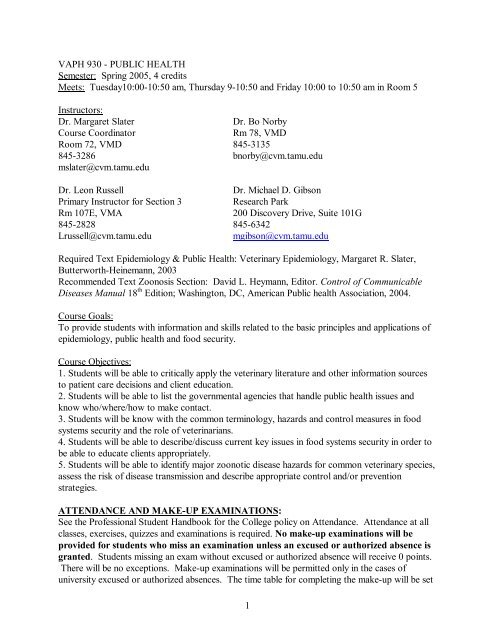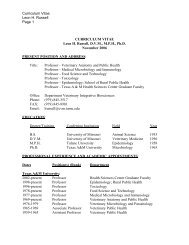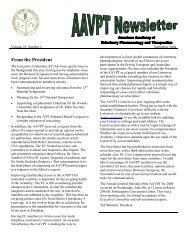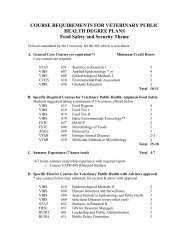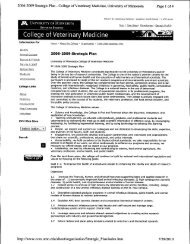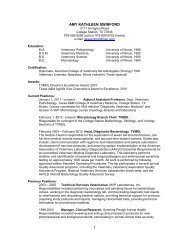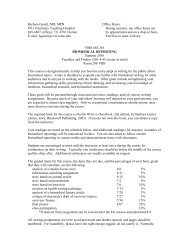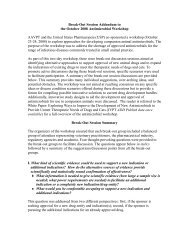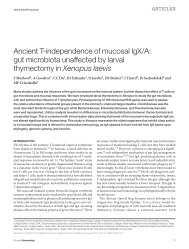1 VAPH 930 - PUBLIC HEALTH Semester - College of Veterinary ...
1 VAPH 930 - PUBLIC HEALTH Semester - College of Veterinary ...
1 VAPH 930 - PUBLIC HEALTH Semester - College of Veterinary ...
You also want an ePaper? Increase the reach of your titles
YUMPU automatically turns print PDFs into web optimized ePapers that Google loves.
<strong>VAPH</strong> <strong>930</strong> - <strong>PUBLIC</strong> <strong>HEALTH</strong><br />
<strong>Semester</strong>: Spring 2005, 4 credits<br />
Meets: Tuesday10:00-10:50 am, Thursday 9-10:50 and Friday 10:00 to 10:50 am in Room 5<br />
Instructors:<br />
Dr. Margaret Slater Dr. Bo Norby<br />
Course Coordinator Rm 78, VMD<br />
Room 72, VMD 845-3135<br />
845-3286 bnorby@cvm.tamu.edu<br />
mslater@cvm.tamu.edu<br />
Dr. Leon Russell Dr. Michael D. Gibson<br />
Primary Instructor for Section 3 Research Park<br />
Rm 107E, VMA 200 Discovery Drive, Suite 101G<br />
845-2828 845-6342<br />
Lrussell@cvm.tamu.edu mgibson@cvm.tamu.edu<br />
Required Text Epidemiology & Public Health: <strong>Veterinary</strong> Epidemiology, Margaret R. Slater,<br />
Butterworth-Heinemann, 2003<br />
Recommended Text Zoonosis Section: David L. Heymann, Editor. Control <strong>of</strong> Communicable<br />
Diseases Manual 18 th Edition; Washington, DC, American Public health Association, 2004.<br />
Course Goals:<br />
To provide students with information and skills related to the basic principles and applications <strong>of</strong><br />
epidemiology, public health and food security.<br />
Course Objectives:<br />
1. Students will be able to critically apply the veterinary literature and other information sources<br />
to patient care decisions and client education.<br />
2. Students will be able to list the governmental agencies that handle public health issues and<br />
know who/where/how to make contact.<br />
3. Students will be know with the common terminology, hazards and control measures in food<br />
systems security and the role <strong>of</strong> veterinarians.<br />
4. Students will be able to describe/discuss current key issues in food systems security in order to<br />
be able to educate clients appropriately.<br />
5. Students will be able to identify major zoonotic disease hazards for common veterinary species,<br />
assess the risk <strong>of</strong> disease transmission and describe appropriate control and/or prevention<br />
strategies.<br />
ATTENDANCE AND MAKE-UP EXAMINATIONS:<br />
See the Pr<strong>of</strong>essional Student Handbook for the <strong>College</strong> policy on Attendance. Attendance at all<br />
classes, exercises, quizzes and examinations is required. No make-up examinations will be<br />
provided for students who miss an examination unless an excused or authorized absence is<br />
granted. Students missing an exam without excused or authorized absence will receive 0 points.<br />
There will be no exceptions. Make-up examinations will be permitted only in the cases <strong>of</strong><br />
university excused or authorized absences. The time table for completing the make-up will be set<br />
1
y the instructor. Students are responsible for all missed work (including check <strong>of</strong>f and graded<br />
work) regardless <strong>of</strong> type <strong>of</strong> absence. For excused or authorized absences, student may make up<br />
the work; it will be due at a time designated by the instructor.<br />
Check <strong>of</strong>f assignments will be counted as long as the student has made a good faith effort to do<br />
the work. Students who have not made such an effort will not receive credit for the assignment.<br />
Students are also responsible for checking their email for any announcements or reminders about<br />
the course during the semester.<br />
NOTICE:<br />
The course instructors reserve the right to administer unannounced quizzes during any class.<br />
HONOR CODE AND PROFESSIONAL ETHICS:<br />
ASince the integrity <strong>of</strong> the veterinary medical pr<strong>of</strong>ession is a reflection <strong>of</strong> the sum <strong>of</strong> the integrity<br />
<strong>of</strong> its members, veterinary medical students should conduct themselves..... in an exemplary ethical<br />
and pr<strong>of</strong>essional manner. (Pr<strong>of</strong>essional Student Handbook)@<br />
Scholastic dishonesty, in any form, will not be tolerated. This means no cheating <strong>of</strong> any kind.<br />
Scholastic dishonesty includes, but is not limited to, looking at examination <strong>of</strong> another student,<br />
consulting notes or references during a closed book examination, providing information or<br />
seeking information from another student during an examination or between laboratory and<br />
written examination sessions, accessing an unauthorized website during an examination,<br />
plagiarism, etc. The instructors reserve the right to dismiss from the course and administer a<br />
course grade <strong>of</strong> "F" to any student involved in incidents <strong>of</strong> scholastic dishonesty.<br />
On all examinations, students will confirm their compliance with the <strong>College</strong>=s Honor Code by<br />
writing and signing the following statement:<br />
"On my honor, I have neither given nor received and aid on this examination."<br />
(student signature)<br />
A student who does not sign the pledge will be asked to do so before the examination is graded.<br />
The pledge serves primarily as a reminder to the student and teacher that the <strong>College</strong> has an<br />
Honor Code, however, absence <strong>of</strong> the signed pledge does not remove an examination from<br />
coverage by the Honor Code.<br />
Lastly, it is both pr<strong>of</strong>essional and courteous to come to class on time. Entering the classroom<br />
after the beginning <strong>of</strong> class is disruptive to your classmates.<br />
ADA POLICY STATEMENT:<br />
The Americans with Disabilities Act (ADA) is a federal anti-discrimination statute that provides<br />
comprehensive civil rights protection for persons with disabilities. Among other things, this<br />
legislation requires that all students with disabilities be guaranteed a learning environment that<br />
provides for reasonable accommodation <strong>of</strong> their disabilities. If you believe that you have a<br />
disability requiring accommodation, please contact the Department <strong>of</strong> Student Life Services for<br />
Students with Disabilities in Room 126 <strong>of</strong> the Koldus Building promptly at the beginning <strong>of</strong> the<br />
semester. The phone number <strong>of</strong> this <strong>of</strong>fice is 845-1637.<br />
2
COURSE GRADING:<br />
Epidemiology & Public Health, classes 1- 39 will count for 67% <strong>of</strong> the course grade.<br />
Zoonoses, classes 40 – 60 will count for 33% <strong>of</strong> the course grade.<br />
For Epidemiology & Public Health section:<br />
26%: graded exercises<br />
15%: quizzes<br />
25% ungraded but required exercises<br />
34%: exams 1 & 2<br />
For Zoonosis section:<br />
30% presentation<br />
30% powerpoint slides and client information sheet.<br />
10% student evaluations their group members<br />
30% zoonoses examination.<br />
ZOONOSES PRESENTATIONS:<br />
The objective <strong>of</strong> these presentations is to allow you to use what you know about the assigned<br />
zoonotic disease, plus any written or web page sources <strong>of</strong> information, to solve a real-world type<br />
<strong>of</strong> zoonotic disease problem just like you may experience in practice after graduation from the<br />
CVM.<br />
The assignment for each zoonosis group consists <strong>of</strong> five elements: 1) power point slides; 2) a<br />
client information sheet; 3) an oral presentation; 4) a case study within the oral presentation; and,<br />
5) a confidential evaluation <strong>of</strong> each <strong>of</strong> the other members in each group.<br />
Power Point Slides: You can use any source <strong>of</strong> information except faculty or students outside<br />
your Group. If you use printed materials, only current texts or journals published in the last three<br />
years will be acceptable. If you use online sources, use only those <strong>of</strong> pr<strong>of</strong>essional organizations<br />
(e.g. AVMA), recognized disease control agencies (e.g.,CDC) or academic institutions (e.g. St.<br />
Louis University). List references in appropriate slides or at the end <strong>of</strong> the slide presentations. and<br />
prepare a one-page, bullet-point, client education handout.<br />
Each Group will send or e-mail the instructor a PowerPoint draft and a client information sheet at<br />
least ten (10) days before the group is scheduled to present their zoonotic disease information to<br />
the class. The instructor for the zoonoses section will critique the PowerPoint materials, and will<br />
inform each group <strong>of</strong> errors or deficiencies in their materials at least 5 days before their assigned<br />
presentation date. Once the materials are corrected, the group’s PowerPoint presentation will be<br />
placed on “T” drive where it will be available to the <strong>VAPH</strong> <strong>930</strong> class for their review and study.<br />
Client Information Sheet. This should be written in non-scientific language, and should tell the<br />
client about the zoonotic potential that his or her animal is presenting. Also, you need to educate<br />
all <strong>of</strong> your clients on how to prevent exposure <strong>of</strong> their animals and humans to the suspected<br />
zoonosis. The client information sheet should be attractive (with art work), bullet-pointed, and<br />
short (one or two pages).<br />
Use your creativity, imagination, problem-solving ability, knowledge <strong>of</strong> the zoonoses, and Aggie<br />
teamwork in your zoonoses assignment.<br />
Oral Presentation: This presentation will be prepared by the entire Group. Use you scientific<br />
3
zoonoses knowledge. The presentations will use these PowerPoint visuals, with current references<br />
or WWW sites. It is up to you who and how the oral assignment will be presented. Be creative,<br />
but also be pr<strong>of</strong>essional. You will have a question period at the end <strong>of</strong> your oral presentation.<br />
Every member <strong>of</strong> the group must have an actively visible part in the class presentation. Allow at<br />
least seven minutes for questions at the end <strong>of</strong> your presentation.<br />
The presentations will include the following (each <strong>of</strong> the 10 parts will be worth 10% ):<br />
1. Definition <strong>of</strong> the zoonoses. Common names that may be used, e.g. mad cow disease for<br />
bovine spongiform encephalopathy.<br />
2. Etiology: The agent characteristics that are responsible for its occurrence in an area; e.g., the<br />
spore <strong>of</strong> Bacillus anthracis persists for decades in the soil <strong>of</strong> some places in Texas.<br />
3. Occurrence: Where and when does the disease usually occur. Who does it affect? Example:<br />
Bat rabies occurs in the US in late summer. Over 75 % <strong>of</strong> cases in the US during the past 15 years<br />
have been caused by bat-types <strong>of</strong> rabies viruses.<br />
4. Clinical Manifestations: Clinical signs <strong>of</strong> the disease in humans; e.g., leishmaniasis may cause<br />
severe disfiguring skin lesions in people as well as serious disease <strong>of</strong> the visceral organs.<br />
Include the major clinical signs <strong>of</strong> animals that the veterinary practitioner should know. For<br />
example, what are the clinical signs <strong>of</strong> sylvatic plague that are presented by the domestic cat.<br />
5. Transmission: The source <strong>of</strong> exposure and mode <strong>of</strong> transmission from the animal host to<br />
humans. Also, the reservoir animal: e.g., in Western Equine Encephalitis, the reservoir seems to<br />
be passerine birds, and the source is the mosquito, Culex tarsalis.<br />
6. Diagnosis: The A gold standard@ for diagnosis in humans, and animals if they are available; e.g.,<br />
the Lyme Disease ELISA test for humans, and SNAP@ test for dogs.<br />
7.Differential Diagnosis: Include the diseases that may present similar signs.<br />
8. Therapy: The usually recommended treatment regimen; e.g., cipr<strong>of</strong>loxacin, doxycycline, and<br />
penicillin G for anthrax in humans. Penicillin and tetracycline in animals.<br />
9. Prophylaxis, Prevention and Control: The current accepted prevention and control<br />
measures; e.g. vaccination <strong>of</strong> horses for West Nile Virus and reduce exposure to mosquitoes.<br />
Humans should avoid exposure, use protective clothing and/or mosquito repellants such as Deet.<br />
10. Bioterrorism Implications. The Bioterrorism potential and the method <strong>of</strong> exposure; e.g.,<br />
anthrax is a class A bioterrorism agent, and the spores can be disseminated by aerosol.<br />
Case Study: Make this a problem solving exercise where you decide, develop or create a<br />
fictitious case study. You should pose this problem case at the beginning and the best solution at<br />
the end <strong>of</strong> your presentation.<br />
Confidential Evaluations: Each student will turn in a confidential evaluation <strong>of</strong> the participation<br />
and value to Group’s project by each <strong>of</strong> the other members <strong>of</strong> their respective group. Please give<br />
a numerical value (%). Personal comments about the work ethic <strong>of</strong> individuals is encouraged. This<br />
may be e-mailed to Dr. Russell.<br />
Grades: Each group will be graded and each student in the group will receive the same grade,<br />
minus points for any negative confidential grade. The grades will be based on creativity, science,<br />
and effort. Group presentation grades will account for 30% <strong>of</strong> each student’s zoonoses grade:<br />
PowerPoint (using the 10 items listed above) and client information sheet will count 30% grade:<br />
the zoonoses exam will count 30% <strong>of</strong> the grade; and, confidential evaluations 10%.<br />
Each group will submit 5 multiple choice questions to Dr. Russell to be used in the exam.. Please<br />
have those to him at least 7 days before the exam.<br />
ZOONOSES GROUP ASSIGNMENTS:<br />
4
Last Name First Name Group<br />
Last<br />
Name First Name Group Last Name First Name Group<br />
Abbott Ashlie 1 Gable Gadriel 8 Nichols Travis 15<br />
Abraham Brad 1 Gerhardt James 8 Odle Jill 15<br />
Agnese Nancy 1 Giles Brian 8 Parker Jennifer 16<br />
Albers Kerbey 1 Glade Michael 8 Payne Sherrie 16<br />
Anderson Melissa 1 Gore Jennifer 9 Pohler Cody 16<br />
Barnes Catherine 1 Greenwell Katherine 9 Potscavage Allison 16<br />
Barron Krista 2 Gregoire Megan 9 Purcell Sally 16<br />
Bayer Diana 2 Guest April 9 Ramirez Lisa 16<br />
Bechtol Sarah 2 Gurasich Amy 9 Ray Anne 17<br />
Beckworth Laura 2 Heineman Jodie 9 Reeves April 17<br />
Belote Patricia 2 Henry Amanda 10 Rippy Amy 17<br />
Belz Katie 2 Hensarling Amber 10 Rowan Teresa 17<br />
Bendall Matthew 3 Hurt Christina 10 Sager Layne 17<br />
Bennett Brad 3 Jacques Ryan 10 Sanchez Eduardo 17<br />
Berry Amanda 3 Johnson James 10 Short Jennifer 17<br />
Blinn Jamie 3 Johnston Jered 10 Simmonds Stacy 18<br />
Borchers Candace 3 Kaspar Krist<strong>of</strong>fer 11 Simonson Stephanie 18<br />
Brown Amber 3 Keller Dominique 11 Sirman Bart 18<br />
Brown Michael 4 Kelley Heather 11 Smith Jacqueline 18<br />
Brown Susan 4 Klett Rachel 11 Snyder Jessica 18<br />
Burpee Pavlina 4 Krause Angela 11 Solomon Seth 18<br />
Carr Adam 4 Kurtz Kelley 11 Soranaka Eddy 18<br />
Carter Staci 4 Lacey Coalson 12 Southerland Amy 19<br />
Cassens Annetrea 4 Lamb Lauren 12 Speed Rachel 19<br />
Cauthen Laura 5 Landis Ellen 12 Stewart Laura 19<br />
Cavitt Justin 5 Leach Stacey 12 Swim Emily 19<br />
Chacon Genny 5 Lee Ryan 12 Tatman Shawn 19<br />
Chaffee Beth 5 Leestma Katie 12 Terrazas Luis 19<br />
Christensen Rickie 5 Leonard Nichole 13 Thedford Jennifer 19<br />
Clegg Jennifer 5 Lynch Emily 13 Tovar Tricia 20<br />
Crim Marcus 6 Makarski Lori 13 Tran Quynh 20<br />
Cruz Jessica 6 Marsh Chad 13 Turner Nancy 20<br />
Cruz Veronica 6 Martin Cristalle 13 Vance Leah 20<br />
Culica Alina 6 Martin Thomas 13 Vargas Erin 20<br />
D'orazio Kelly 6 Mcclure Jennifer 14 Vasquez Laura 20<br />
Debender Rachel 6 Mcelwee Dustin 14 Wellman Lindsay 20<br />
Dockins Jennifer 7 Mcmurrey Anna 14 Wells Jennifer 21<br />
Doerfler Heather 7 Miller Lesley 14 Whitehill John 21<br />
Doyle Crystal 7 Morton James 14 Willingham Callie 21<br />
Duncan Courtney 7 Morton Stephanie 14 Willison Susan 21<br />
Epstein Cassie 7 Mulvey Meredith 15 Woller Robin 21<br />
Fitzgerald Brenna 7 Murfee Mary 15 Wunderlich Peter 21<br />
Flores Brenda 8 Neely Austin 15 Wyatt Ladona 21<br />
Gable Gadriel 8 Newton Ross 15<br />
5
CVM COURSE EVALUATION:<br />
All students are expected and requested to complete the CVM Course Evaluation Form on the website near<br />
the end <strong>of</strong> each semester. Students will be notified by e-mail and in class when the Evaluation Forms are to<br />
be completed.<br />
CLASSROOM COMMUNICATION FORM:<br />
A copy <strong>of</strong> the Classroom Communication Form is available from the Office <strong>of</strong> the Associate Dean for<br />
Pr<strong>of</strong>essional Programs or from the TAMU website and students should feel free to use this form should they<br />
feel the need arises during the semester.<br />
THIS SYLLABUS IS SUBJECT TO CHANGE.<br />
Course Content (Lecture periods):<br />
Week<br />
No.<br />
Class No.<br />
Class Content<br />
Article (to<br />
be read by<br />
this class<br />
6<br />
Exercise<br />
Reading<br />
for this<br />
class<br />
Instructor<br />
1 1: 1/6 Introduction to course,<br />
evidence based care, set<br />
groups, expectations<br />
1,2 intro, ch1 Slater/Norby<br />
1 2: 1/6 Clinical Scenarios 3 chs1, 3 Slater<br />
1 3: 1/7 Treatment & Prevention 1,2,3 4 ch 4, pp Slater<br />
- type <strong>of</strong> study<br />
41-2, ch5<br />
2 4: 1/11 - strengths/weaknesses <strong>of</strong> 4 5 (ch 14) Slater<br />
studies<br />
2 5: 1/13 - application, Exercise 2 due 6 Slater<br />
2 6: 1/13 - statistics 7 Slater<br />
2 7: 1/14 - continued 8 ch 6 Slater<br />
3 8: 1/18 Disease Detection, review 5 9 Slater<br />
3 9: 1/20 - evaluating a study Slater<br />
3 10: 1/20 - additional concepts,<br />
Norby<br />
QUIZ 1<br />
3 11: 1/21 - Principles <strong>of</strong> Herd Health ch 12, 13 Slater<br />
4 12: 1/25 - herd level diagnosis Norby<br />
4 13: 1/27 - freedom from disease Norby<br />
4 14: 1/27 - Monitoring & Surveillance 6 Norby<br />
4 15: 1/28 - examples 10 Norby<br />
5 16: 2/1 - food safety, biosecurity Norby<br />
5 17: 2/3 - Food Outbreaks Fosgate<br />
5 18: 2/3 - continued Fosgate<br />
5 19: 2/4 - Monitoring Continued Norby<br />
6 20: 2/8 - continued Norby<br />
6 21: 2/8 Prognosis 7 11 ch 7 Slater<br />
6 22: 2/10 Review Slater/Norby<br />
2/11 Exam 1: 8:00 – 8:50 am
6 23: 2/11<br />
Room 101<br />
- continued Slater<br />
7 24: 2/15 Causation ch 8 Slater<br />
7 25: 2/17 - exercise 8, 9, 10 12 Slater<br />
7 26: 2/17 - how do we prove it? Slater<br />
7 27: 2/18 Antimicrobial Resistance Norby<br />
8 28: 2/22 - small animal Slater<br />
8 29: 2/24 - agricultural Norby<br />
8 30: 2/24 - continued 13 Norby<br />
8 31: 2/25 - HACCP & risk assessment Norby<br />
9 32: 3/1 TBA QUIZ 2<br />
9 33: 3/3 Inspection Kruskopf<br />
9 34: 3/3 - continued Kruskopf<br />
9 35: 3/4 Free-roaming animals &<br />
Public Health<br />
Slater<br />
10 36: 3/8 Real world outbreaks Lillibridge<br />
3/9-11 No Class, Symposium<br />
3/14-18 No Class, Spring Break<br />
11 37: 3/22 Review Norby/Slater<br />
11 38: 3/24 Inspection McDougal<br />
11 39: 3/24 - continued McDougal<br />
3/25 Exam 2: 8:00 – 8:50 am<br />
Room 101<br />
11 40: 3/25 Zoonotic Tuberculosis & Paratuberculosis Group<br />
1<br />
Russell, Gibson<br />
12 41: 3/29 Giardiasis & Cryptosporiosis & Cyclosporiasis 2 Russell, Gibson<br />
12 42: 3/31 Brucellosis & Leptospirosis<br />
3 Russell, Gibson<br />
12 43: 3/31 Glanders & Melioidosis 4 Russell, Gibson<br />
12<br />
13<br />
13<br />
44: 4/1<br />
45: 4/5<br />
46: 4/7<br />
Chlamydiosis<br />
Toxoplasmosis & Cryptosporidiosis<br />
Bartonellosis & Pasteurellosis<br />
5<br />
6<br />
7<br />
Russell, Gibson<br />
Russell, Gibson<br />
Russell, Gibson<br />
13<br />
13<br />
47: 4/7<br />
48: 4/8<br />
Tularemia & Bubonic Plague<br />
Anthrax & SARS<br />
8<br />
9<br />
Russell, Gibson<br />
Russell, Gibson<br />
14 49: 4/12 Salmonellosis & Campylobacteriosis 10 Russell, Gibson<br />
14 50: 4/14 Rabies 11 Russell, Gibson<br />
14 51: 4/14 Transmissible Spongiform Encephalopathies 12 Russell, Gibson<br />
14 52: 4/15 Equine Encephalitis (WEE, EEE, & W.Nile ) 13 Russell, Gibson<br />
15 53: 4/19 Monkey Pox and Monkey B Virus 14 Russell, Gibson<br />
15 54: 4/21 Hemorrhagic Fevers, Hendra/Nipah Disease 15 Russell, Gibson<br />
15 55: 4/21 Visceral, Larval and Cutaneous Migrans 16 Russell, Gibson<br />
15 56: 4/22 Chagas Disease & Trypanosomiasis 17 Russell, Gibson<br />
16 57: 4/26 Hydatid Disease & Cysticercosis 18 Russell, Gibson<br />
7
16 58: 4/28 Leishmaniasis & Amebiais 19 Russell, Gibson<br />
16 59: 4/28 RMSF, Ehrlichiosis & Murine Typhus 20 Russell, Gibson<br />
16 60: 4/29 Lyme Disease<br />
5/3 Exam 3: 10:00 – 11:50 am Room 5 During<br />
Finals<br />
8<br />
21 Russell, Gibson<br />
THESE ARE THE TERMS WHICH WILL BE EXAMINED ON THE QUIZES!!! (Quiz 1: 1/20, Quiz 2:<br />
3/1)<br />
You should be able to explain what they are in your own words, give an example, and use appropriately.<br />
Primarily Quiz 1<br />
Accuracy<br />
Analytical studies<br />
Bias<br />
Case-Control Studies<br />
Categorical (discrete) data<br />
Cohort Studies (follow-up or, incorrectly, prospective studies)<br />
Continuous data<br />
Cross-Sectional Studies<br />
Descriptive studies<br />
Experimental studies<br />
Exposure (exposed (E+), unexposed (E-))<br />
Incidence<br />
Negative predictive value (NPV)<br />
Nominal data<br />
Observational studies<br />
Ordinal data<br />
Outcome (diseased (D+), non-diseased (D-))<br />
P-value<br />
Positive predictive value (PPV)<br />
Power<br />
Precision<br />
Prevalence (pre-test probability)<br />
Prospective<br />
Random assignment or randomization<br />
Relative risk or risk ratio (RR)<br />
Retrospective<br />
Sensitivity (true positive rate, TPR, Se)<br />
Specificity (true negative rate, TNR, Sp)<br />
Test<br />
Primarily Quiz 2<br />
Antimicrobial resistance<br />
Food safety
Food security<br />
Monitoring<br />
Prevalence (pre-test probability)<br />
Public Health<br />
Surveillance (active vs passive)<br />
CHECKING YOUR UNDERSTANDING:<br />
Treatment and Prevention Study Design and Evaluation:<br />
What you should know:<br />
Understand the difference between means and medians and when to use them.<br />
Know what categorical and continuous data are.<br />
Be able to tell if something is statistically significant given a p-value and to describe what that p-value means.<br />
Realize that what is printed (or stated) is not always correct.<br />
Know that fewer animals in a study may mean that there may not be enough for a statistically significant<br />
result.<br />
Know that fewer animals in a study may mean that they may not be representative in important ways <strong>of</strong> the<br />
population you are dealing with or interested in.<br />
What you should be able to do:<br />
Be able to state a clinical question from a clinical scenario.<br />
Be able to tell if a study is retrospective, prospective, observational, experimental, analytical or descriptive.<br />
Be able to identify exposure and outcome in an epidemiological study.<br />
Be able to identify and describe the key characteristic <strong>of</strong> each specific study design (emphasis on clinical trials,<br />
cohorts and case series).<br />
Be able to determine how good an article or other resource is using the guidelines from class.<br />
Be able to identify and describe at least 2 strengths and weaknesses for a study.<br />
Be able to tell if a study is randomized or blinded and what that means.<br />
Be able to distinguish incidence and prevalence.<br />
Be able to describe what a p-value tells you<br />
Disease Detection (first part…more to follow):<br />
What you should know:<br />
Understand what ROC and AUC tell you about a test (and how they are related to one another)<br />
Understand the trade <strong>of</strong>f between sensitivity and specificity for tests with continuous outcomes<br />
What you should be able to do:<br />
Be able to decide how good an article on testing is<br />
Be able to identify the gold standard and decide if it is a good one<br />
Be able to calculate predictive values given a test=s sensitivity and specificity.<br />
Be able to predict the direction <strong>of</strong> change for a predictive value with changes in prevalence.<br />
Be able to list 3 ways to determine a disease=s prevalence.<br />
Understand and describe the importance <strong>of</strong> the disease severity or stage on sensitivity and specificity.<br />
Be able to describe the effect <strong>of</strong> changing a cut-<strong>of</strong>f on a test with a continuous measurement on sensitivity<br />
and specificity<br />
9
Be able to identify and give examples <strong>of</strong> continuous and categorical variables<br />
Be able to describe the general components <strong>of</strong> a Apopulation health@ program.<br />
Prognosis and Causation:<br />
What you should know:<br />
The concept that causation is an interrelated set <strong>of</strong> factors.<br />
What are some <strong>of</strong> the common models to describe causation.<br />
What are the criteria to determine causation.<br />
Be able to recognize some common statistical tests and when they might be used.<br />
What survival analysis is in general terms<br />
What you should be able to do:<br />
Be able to describe when to use a mean or median and to tell if they are used appropriately in an example.<br />
How to calculate and interpret a morbidity or mortality rate.<br />
How to interpret a relative risk and odds ratio and decide whether they are statistically significant or not.<br />
How to interpret a survival curve in an example<br />
What the agent, host, environment triangle means and list some examples for each element.<br />
Be able to describe and identify a clinically or biologically important difference compared to a statistically<br />
significant difference.<br />
AMR and Inspection still to come….<br />
10


